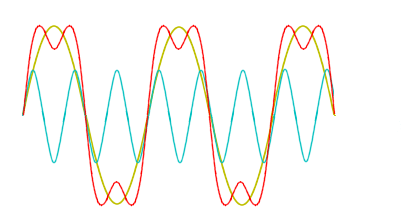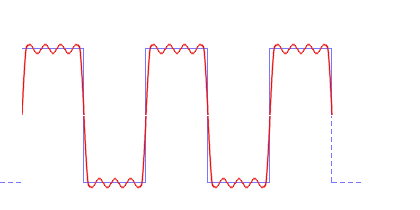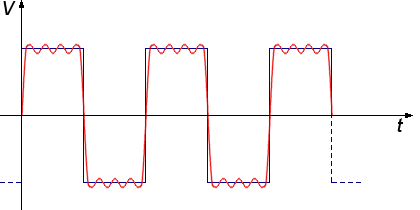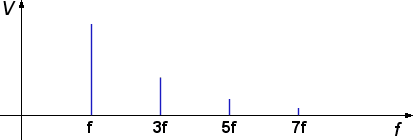Fast Fourier Transformation

Figure 1: The fundamental mode sinus (amber) and its third harmonic wave (cyan), the sum of the amplitudes of these signals forms almost a rectangle signal (red).

Figure 2: Already the fifth harmonic wave as a third sine signal describes the rectangle signal very clear.

Figure 3: Representation of the rectangle signal as a frequency spectrum.

Figure 1: The fundamental mode sinus (amber) and its third harmonic wave (cyan), the sum of the amplitudes of these signals forms almost a rectangle signal (red).

Figure 2: Already the fifth harmonic wave as a third sine signal describes the rectangle signal very clear.

Figure 3: Representation of the rectangle signal as a frequency spectrum.

Figure 1: The fundamental mode sinus (amber) and its third harmonic wave (cyan), the sum of the amplitudes of these signals forms almost a rectangle signal (red).

Figure 2: Already the fifth harmonic wave as a third sine signal describes the rectangle signal very clear.

Figure 3: Representation of the rectangle signal as a frequency spectrum.
Fast Fourier Transformation
The Fourier- transformation was developed by the French mathematician Jean Baptiste Joseph Fourier in 1822 in his book Théorie analytique de la chaleur. The signal received by a pulsed radar is a time sequence of pulses for which the amplitude and phase are measured. Doppler processing techniques are based on measuring the spectral (frequency) content of this signal. The frequency content of this time-domain signal is obtained by taking its Fourier transformation, thus turning it into a frequency-domain signal or spectrum of the time-domain signal.
The Fourier- transformation has become a fundamental method in the signal processing procedures, since the radar echo contains a variety of informations in the signal form. This information is convicted by the Fourier- transformation into a data format which can be used by the computer-aided signalprocessing.
The Fourier transformation is a form of an analysis, taking the signal form into its sines and cosines components (base functions), this means, the signal form is decsribed as a sum of sine or cosine waves of different frequency, phase and amplitude. This analysis is called Diskrete Fourier Transformation (DFT), to distinguish this form of analysis of Fast Fourier Transformation (FFT).
In the accompanying diagrams you can see as an example as a rectangle signal arises from the sum of a sine voltage with its odd harmonic waves. The representation of the rectangle signal as a frequency spectrum has the advantage of an easy description by a table with the details for frequency and amplitude. Remember: Tables are ideal database for a computer-aided signal processing.
Unfortunately, the conversion is a very time-consuming procedure. The Fast Fourier Transformation, however, is a (technical) software variant of a fast algorithm only. The speed of analysis will achieved by
- the choice of a sufficiently suitable mathematical algorithm
- the avoidance of multiplications (multiplications need more run time than additions in a computing program absolutely)
- first results still can already be made available during the calculation as an approach.
With help of the fast Fourier analysis whole signal forms of radar echos can be stored as only few data by the digital signalprocessing. These data can be used by the process of the identification of radar targets like fingerprints.
mathematical basics: www.mathepower.com (in German only)
more information: www.iti.fh-flensburg.de (in German only)
Matteo Frigo and Steven G. Johnson: FFTW, http://www.fftw.org/;
The Design and Implementation of FFTW3, Proceedings of the IEEE 93 (2), 216–231 (2005).
